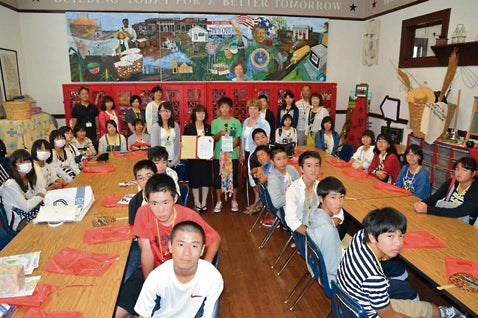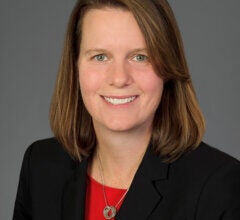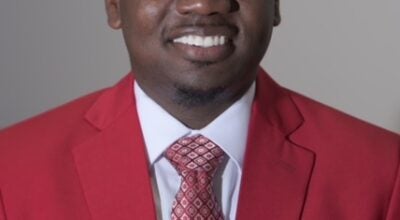1,000 cranes for President Carter
Published 5:05 pm Thursday, August 27, 2015

- The group from Miyoshi City, Japan, at the Jimmy Carter National Historic Site with Annette Wise.
Exchange students bring paper birds for good health
AMERICUS — They flew over Sumter County in small, single-engine airplanes, visited National Park Service Sites at Andersonville and Plains, saw an underwater marriage proposal at the Flint River Aquarium, visited schools in the district where students performed for them, and ate food they had never tasted before in their lives. Although they had a full and rewarding visit, it was the one part they missed this year that caused them to come together as a community and create by hand 1,000 paper origami birds.
“We are all so worried about the health of President Carter,” said Japanese delegation member Sayoko Sakai. “There is a Japanese belief that if you give a person a thousand of these paper cranes, you are hoping they will recover from their illness.”
The exchange program is part of a unique cultural exchange offered through the school district whereby students and families from Sumter County Schools host students and adult delegates from Miyoshi City, Japan. Then in March, local students will have the opportunity to travel to Japan as guests of the Japanese. Jimmy Carter inspired the exchange, which has gone on for 25 years.
Miyoshi City is in the Hiroshima Prefecture, near the city where the atomic bomb was dropped during World War II. One-thousand paper cranes have become a symbol of peace and wellness when a young survivor of the bombing, Sadako Sasaki, came to believe that creating the thousand cranes from the Japanese origami tradition of paper folding would help her survive the leukemia that overcame her 10 years after the blast.
Just as the Japanese were traveling from Atlanta to Americus, Jimmy Carter was holding a press conference announcing to the world that he would soon be undergoing treatments for cancer. However, word of the former president’s illness had gotten to the delegation just days before their departure for the states. Like those who had been alive during the assassination of John F. Kennedy, each of the members of the Japanese delegation can recall exactly where they were when they heard the news of Carter’s cancer.
The paper cranes were presented to Annette Wise, director of Education at the Jimmy Carter National Historic Site, at the time and place in their tour where, for the past quarter-century, the group would have met with the former president who helped to create the exchange.
“Because we found out just before we left, it took an enormous effort on the part of everyone in the city to make all of the birds,” said Sasaki. “By the time we were taking the train to the airport in Japan, we were still stringing them together.”
For two of the members of the delegation, this trip marked a coming of age, as they had originally visited Americus as students about a decade earlier and now they returned as teachers.
“The first time I came here, everything was new,” said Tomomi Katayama, who had visited Americus 12 years earlier. “I was surprised at how friendly everyone was, how they opened their homes to us. It was my first trip out of the country and it gave me confidence to travel and learn English. Since then, I’ve been to New York, Singapore, Canada and Guam.”
But to Katayama and to Mami Arakawa, who had come to Americus 10 years earlier as a student, traveling to Americus is like returning home.
“Each year for 25 years, we have sent a delegation from our city to Americus,” she said. “So it’s always been a part of my life.”
From the very beginning, Arakawa has been impressed with the initiative of Sumter County students.
“My first time here, I was surprised to see all the students in the middle school enthusiastically volunteering to sing for us,” she said. “They were so confident and not at all afraid to show their confidence.”
Both of them recalled meeting President Carter for the first time and recalled how friendly he was to them.
“He was a president of the United States and a Nobel Prize winner who had Secret Service all around him, and yet he went out of his way to shake my hand,” said Katayama.
Some of the students coming for the first time were expecting a much more violent and turbulent America than they encountered based on what they had seen in movies and in video games that came from America.
“When compared to Japan, the rules and regulations in the United States are much fewer,” said Raiki Miyamoto. “But when we visited the schools in the Sumter County system, all the students were walking in line as they were told and we were very impressed with how obedient they all were.”
Chris Usrey, director of Technology for Sumter County Schools, and who was responsible for planning and executing the trip, took students and adults on plane rides from Jimmy Carter Regional Airport at Souther Field. Also flying members of the delegations was pilot Paul Pearson, Maintenance manager at Souther Field Aviation.
“The exchange program is extremely important to us,” said Sumter County School Superintendent Donny Smith. “It gives our students the opportunity to make lasting friendships and expand their worlds while promoting good will among the countries.”
The delegation also had dinner at the Lee Council House with a group from the local Shriners Club, an organization that has traditionally gone out of their way to host the delegation.
During a visit to the Flint River Aquarium in Albany, members of the group witnessed a fish feeding, where scuba divers descended into the main tank to feed the very large river fish. The divers and the fish were on one side of a thick glass wall and the spectators on the other. Unexpectedly, one of the divers pulled out a sign with a woman’s name on it, then flipped it over, and it read: “Will you marry me?” Her tears and laughter seemed to indicate the response.

Annette Wise, director of education at the Jimmy Carter National Historic Site, holds the 1,000 paper cranes to be given to President Jimmy Carter from the group visiting from Miyoshi City, Japan.

Chris Usrey stops for a photo before taking members of the group from Miyoshi City, Japan, for a flight over Sumter County.






